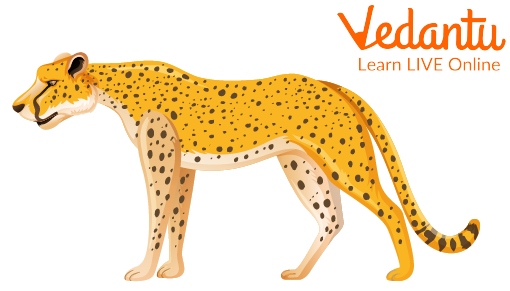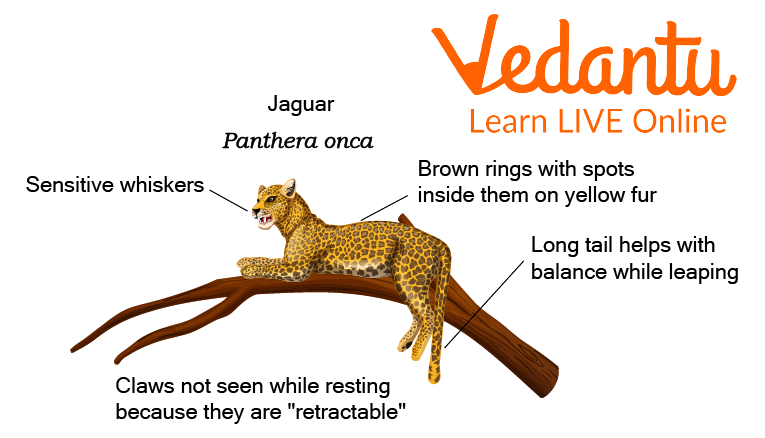




Introduction to Jaguars
Kids, do you know what wild animals are? Wild animals are those animals that cannot be domesticated or kept as pets. They roam freely in the jungle and hunt other animals to survive.

The Magnificent Jaguar
Jaguar comes from the word “yaguar”, meaning “he who kills with one leap”. They are the third biggest cat in the world, right after tiger and lion, and the biggest cats in America. Jaguars can be located in North, South, and Central America. They are also the only living member of the Panthera native to America.
There is a black form of the Jaguar as well. It has black ground colour with black spots called the Black Panther. This sub-species of jaguar can be found more commonly in Asia than in other parts.
Physical Features of Jaguars
Being the majestic animals that they are, let's throw some light on the physical features of jaguars:
Jaguars have an exceptionally swift and agile bodies.
Their coats help them camouflage in their surroundings.
Every jaguar coat has a different and unique pattern to be individually identified.
Their tail itself measures 80 cm, excluding their length.
Even though they can make big leaps almost 10 feet high, jaguars have short legs.
Their heads are round and large.
Their tongues have sharp-pointed bumps known as papillae, which help them to scrape the meat from their prey.
They have teeth so strong that they can easily take down preys that are even 3-4 times their weight.
Habitat
Where do you think jaguars like to live? We often find a jaguar near a low-lying tropical habitat closer to lakes, rivers, and inland wetlands.
Before losing their land to habitat loss, Jaguars could be located in the Southwestern part of the USA to the grasslands of Argentina. But currently, their movement is restricted to the rainforests of the Amazon.
Brazil takes pride in having almost 50% of the jaguars alone. The remaining 50% are divided into 8 countries that share the Amazon forest: Peru, Bolivia, Ecuador, Colombia, Guyana, Venezuela, Suriname, and French Guiana.
What Do Jaguars Eat?
As we know, Jaguars are carnivorous mammals, and their diet is rich in meat and fish. Jaguars are not only good swimmers, but they are very good climbers as well. Therefore, they can eat anything and everything they can prey upon or whatever crosses their way, like deer, tortoises, iguanas, fish, birds, and even monkeys.

Jaguar Family
Interesting Facts About Jaguars
Though there are many things to know and discover about wolves, let us begin with some interesting facts about wolves:

Features of Jaguar
Some Facts About Jaguars
Now that we have gathered some basic information on jaguars, let us learn some more facts about jaguars.
Jaguars are known for being loners. They like to live alone.
But Jaguars are territorial animals, meaning they mark or define their territory by clawing trees or with their waste.
Female jaguars can give birth to 1 - 4 cubs at one time.
At birth, the cubs depend on their mother as they are born blind. For almost 2 years, the mother stays with the cubs, protects them from predators, and teaches them to hunt.
Fun Facts for Kids
Now that we have collected some facts about jaguars, let's share some interesting, fun facts for kids:
Jaguars constitute the largest cat in America.
Jaguar;’s regular call is called a “saw” because their call sounds like a sawing of wood.
Do you know what jaguars do when they greet each other? They make a noise like a nasally snuffling.
Can you believe that the jaguar's jaw is so powerful that its one bite exerts more force than a lion's?
It is astounding that jaguars are nocturnal, which means they can hunt both during the day and at night.
Jaguars are quite excellent at swimming, just like tigers and enjoy their time in the water. They are so confident swimmers that they can cross large rivers.
You will be amazed that Jaguars stalk their prey and then ambush them.
They either leap into the water or from a tree to ambush their prey.
They can easily bite through the shell of turtles because of their strong teeth.
Summary
Even thorough Jaguars are known as savage predators and have quite an important role in controlling the population and helping maintain a balance in the food chain. I know it might be quite hard to believe, but in many South American cultures, these powerful cats were worshipped as gods.
We hope you enjoy reading this article. Protecting the jaguars and their habitat is essential as it will also help the other wildfires. In case of any other doubts, feel free to ask in the comments.
FAQs on Interesting Facts About Jaguars
1. What are some interesting facts about jaguars for children?
Jaguars are fascinating big cats with many unique features. Here are some key facts about them:
Powerful Bite: Jaguars have the strongest bite of all big cats relative to their size, powerful enough to pierce the shells of turtles.
They Love Water: Unlike many other cats, jaguars are excellent swimmers and often hunt in rivers and swamps.
Unique Spots: Their beautiful coat is covered in markings called rosettes, which look like roses. Inside these rosettes, jaguars have smaller black dots, which leopards do not have.
Solitary Hunters: Jaguars prefer to live and hunt alone, using their stealth and power to catch prey.
Meaning of the Name: The word 'jaguar' comes from the Native American word 'yaguar', which means 'he who kills with one leap'.
2. How can you tell the difference between a jaguar and a leopard?
While they look similar, you can tell a jaguar from a leopard by looking at two main things. First, check their spots, which are called rosettes. A jaguar's rosettes are large and have one or more small black dots in the center. A leopard's rosettes are smaller and do not have dots inside. Second, jaguars have a much stockier and more muscular build with shorter legs and a broader head compared to the leaner, longer-bodied leopard.
3. Where do jaguars live and what is their habitat like?
Jaguars are native to the Americas, living in a range that stretches from the Southwestern United States down to northern Argentina. Their ideal habitat is a dense rainforest, but they are also very adaptable. You can find them in other environments like swamps, wetlands, and grasslands, as long as there is a good source of water and enough prey to hunt.
4. What makes the jaguar a special and important animal in its ecosystem?
The jaguar is special because it is an apex predator, meaning it is at the top of the food chain with no natural predators of its own. This makes it a keystone species, which is vital for keeping its ecosystem balanced and healthy. By hunting various animals, jaguars control their populations, preventing any single species from becoming too numerous and damaging the forest environment.
5. Why are jaguars such good swimmers, unlike many other big cats?
Jaguars are excellent swimmers because their habitat is often filled with rivers, streams, and wetlands. Their strong, muscular bodies are perfectly adapted for moving through water. They use this ability to their advantage, often hunting prey that lives in or near water, such as fish, turtles, and even caimans. This unique behaviour sets them apart from most other big cats, who tend to avoid water.
6. What are the biggest threats to jaguars today?
The two biggest threats to the survival of jaguars are directly related to human activities. The primary threat is habitat loss due to deforestation in South and Central America, which destroys their homes and isolates their populations. The second major threat is illegal poaching, where humans hunt them for their valuable skins or in retaliation for preying on livestock.
7. What does the name 'jaguar' mean, and how does it describe the animal's hunting style?
The name 'jaguar' originates from the indigenous word 'yaguar,' which translates to 'he who kills with one leap.' This name perfectly describes the jaguar's incredibly powerful and efficient hunting style. They are ambush predators who use stealth to get close to their prey and then deliver a single, decisive bite to the skull or neck, showcasing their immense strength.
8. Are there different species of jaguars in the world?
No, there is only one species of jaguar, scientifically known as *Panthera onca*. While scientists sometimes mention regional variations based on where the jaguars live, these are not considered different species or subspecies. All jaguars belong to the same single species, despite slight differences in size and colouration across their geographic range.









